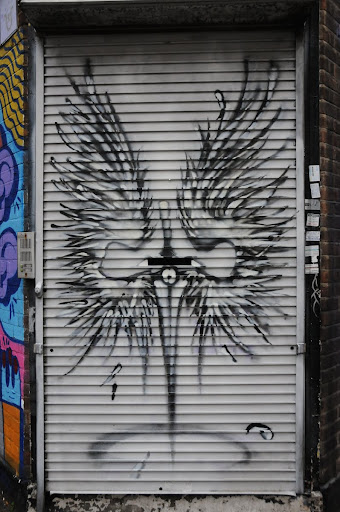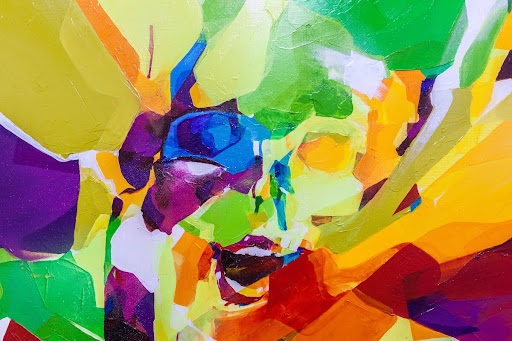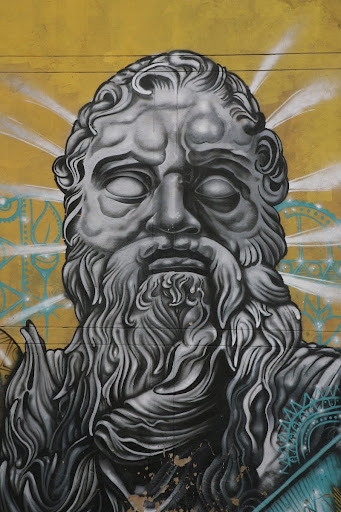
A Snapshot of the Maestro: Jacques Villeglé’s Street Art Legacy
Title: Jacques Villeglé at Les Bains, Résidence d’artistes. Special project. Photo : Stéphane Bisseuil
- Creator: Jacques Villeglé
- Date: 2013
- Location Created: Paris, France
- Location Stored: MoSA, 78, rue Amelot Paris 75011
A Storied Journey: Jacques Villeglé’s Life and Work
Early Years and Artistic Inception
Jacques Villeglé, born in 1926 in Quimper, France, is a historical figure in contemporary French art. His journey began in 1947 in Saint-Malo, where he initiated a collection of found objects, ranging from steel threads to remnants of the Atlantic Wall. Villeglé’s appropriation of the urban environment narrowed down to torn posters in 1949, marking the beginning of his distinctive artistic path.
Collaborations and the Emergence of New Realism
In June 1953, Villeglé, alongside intellectual partner Raymond Hains, published “Hepérile éclaté,” a phonetic poem by Camille Bryen rendered illegible through textured glass screens. This marked a crucial moment as they connected with the Lettrist poet François Dufrêne, subsequently introducing them to Yves Klein, Pierre Restany, and Jean Tinguely. The collaboration culminated in the formation of the New Realists group in April 1960 in Milan, following their joint participation in the first Biennale des jeunes de Paris.
Pioneering Concepts and Sociopolitical Exploration
Before these milestones, in 1958, Villeglé penned “Des réalités collectives,” a treatise on torn posters that foreshadowed the New Realists’ manifesto in April 1960. In 1959, he created the entity “Lacéré anonyme.” Known as a collector of anonymous traces of civilization, Villeglé assembled a sociopolitical alphabet from 1969 onwards, paying homage to Professor S. Tchakhotine, author of “Le Viol des foules par la propagande” in 1939. The Sociopolitical Graphics retrospective was held at the Musée Sainte-Croix de Poitiers in 2003.
The Sculptural Turn and Legacy
In 2007, Jacques Villeglé embarked on a sculptural venture, challenging both traditional (bronze, glass) and industrial (corten steel, polished stainless steel, cast iron) techniques. This marked a new chapter in his artistic exploration.
Les Bains Encounter: A Historic Convergence
In 2013, Jacques Villeglé made a surprise visit to Les Bains, joining artists LEK and SOWAT, accompanied by Sophie Duplaix. This historic encounter at a historic venue brought together four generations of street art activists, including Futura 2000 and Popay.
Preservation at MoSA: Honoring Urban Expression
The Museum of Street Art (MoSA) in Paris, where Jacques Villeglé’s special project resides, stands as a guardian of urban expression. Located at 78, rue Amelot Paris 75011, MoSA preserves and celebrates the raw energy and evolution of street art.
Legacy and Beyond: Jacques Villeglé’s Lasting Impact
Jacques Villeglé’s contributions to street art, New Realism, and sociopolitical exploration have left an indelible mark on the art world. His work at Les Bains, captured by Stéphane Bisseuil, serves as a testament to the enduring power of artistic expression in unconventional spaces.
In Conclusion
Jacques Villeglé’s journey from collecting found objects to shaping the New Realism movement and exploring sociopolitical themes is a testament to his influence on contemporary French art. The intersection of his work with the vibrant space of Les Bains encapsulates a meeting of artistic minds across generations, emphasizing the timeless and boundary-defying nature of Villeglé’s artistic legacy.

I am a mural enthusiast and a fervent admirer of street art. Rather than creating murals myself, I am passionate about collecting them. My love for street art knows no bounds. I am dedicated to curating and cherishing these artworks that grace the streets. My collection stands as a testament to my profound appreciation for this form of artistic expression.
read about me



